The plethora of news involving mobile devices—most recently the launch of the Verizon iPhone—should serve as a reminder to PR pros to think in terms of the small screen.
Not that a lot of communicators aren’t thinking about using mobile for their campaigns. A recent study by the Association of National Advertisers (ANA) and the Mobile Marketing Association (MMA) shows that 88% of communicators will utilize mobile marketing initiatives this year. Their top focus? Mobile Web sites (see chart).
Which begs the question: Is your Web site ready for mobile devices?
Forecasts predict that in two years there will be as many as 2 billion mobile phone users on the planet. It’s safe to say that some of those users may visit your Web site via an iPhone, Android, BlackBerry or other mobile devices. So what happens if content is cut off, or they have trouble with navigation or the right content is unavailable to them? You may lose a client or customer.
So how can a PR pro get started toward making their organization’s Web site mobile friendly? Or, how can you get started in developing a dedicated mobile site?
“It’s about finding the right resources,” says Richard Ouyang, associate director of digital strategy at Peppercom Digital. “It’s getting the right people to guide you through what tactics would be useful to you—or not.”
 |
| If you haven’t thought much about mobile, other organizations are beating you to the punch. As this late 2010 study shows, nearly two-thirds of communicators either have or plan to implement mobile Web sites to reach customers. Source: Association of National Advertisers/Mobile Marketing Association |
The options are many, says Ouyang, and depending on the depth and breadth of the project, can be expensive for a smaller organization. Yet the greatest challenge is tackling the iterative nature of technology. “Everything is changing so quickly, particularly in tech,” says Ouyang. “So if you don’t hit it right out of the gate, people won’t give you a second chance.”
MOBILE DISCOVERY
To get it right, it’s important to start with the basics. There are three key considerations, says John Ozimek, account director at London-based PepperMobi.
1. Who is the person that is going to be looking at the site via mobile, and what will they want from you?
2. Make sure that content is optimized for mobile. Can a mobile user get to it quickly, and can the content be bookmarked?
3. Make the content relevant to a mobile audience. “Add value to mobile users’ experience, like a geo-location function,” says Ozimek.
Of course, the more you want to target mobile users, the more features—like multimedia or location-based functions—you’ll want to add, which adds to the cost and complexity, says Ozimek, who recommends looking at your existing site and testing it for mobile mojo. On mobiready.com, you can type your URL in and the site will be evaluated for mobile readiness.
There are other tools (some free) available online to help with optimizing your site, like Google Mobile Optimizer. But beware of free services, warns Ozimek, as their logos or product links may be deposited on your site.
FULLY MOBILE
To avoid that, you may want to take that next step of going to a dedicated mobile platform. That was a step that Todd Shingler, owner of Mobile Perspectives, took for promoting an upcoming mobile retail conference in Chicago called Bricks + Mobile (www.remodista.com). Shingler is a big believer in dedicated mobile sites, because “90% of what’s on your regular site is irrelevant to the mobile user,” he says.
Key to keeping the costs down on such a venture, says Shingler, is reusing as much content from your regular site as possible. “You also want your brand to extend in terms of look and feel,” he says.
Here are some strategic considerations from Shingler.
• Make mobile part of your overall digital strategy. “Consider it in the context of all channels used to go to market,” says Shingler.
• Focus on the user experience. “It must be simple and intuitive,” he says. “You want users to come to your site and be happy, or they won’t return.”
• Focus on what basics a mobile user is likely to want. “If you want to add features, it’s fine, but first understand what mobile means in your business,” says Shingler.
Peppercom’s Ouyang has another key piece of advice: tread carefully and thoughtfully. “People throw out, ‘We need to be mobile, we need a Web site,’ without understanding the value and purpose of mobile,” he says. “There must be careful considerations about the content that’s served up, and some knowledge from a technical perspective.”
And one more thing to consider. If social media is a key component of your PR arsenal, remember that more than a third of smartphone users in the U.S. access social networking sites via their mobile browser. So don’t delay implementing an effective mobile strategy. PRN
CONTACT:
Richard Ouyang, [email protected]; John Ozimek, [email protected]; Todd Shingler, [email protected].
